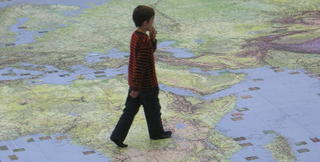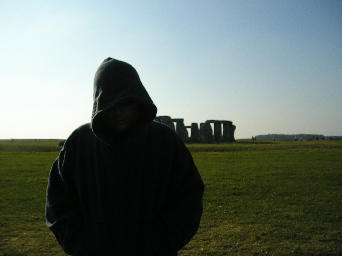The first Saturday that my mother was visiting, we took a day trip to Salisbury and Stonehenge. The tour operator
London Walks offers a number of Explorer Days in which they take guided trips to nearby places. Given that my last London Walks tour ended with a rescue by the coast guard, I had similar high hopes for this trip.
We met the guide at Waterloo Station where we boarded to train for Salisbury. We had a short, guided tour of Salisbury and the
cathedral. (If you’ve read Jude the Obscure, you may be interested to know that, despite the different name, the story actually took place here in Salisbury.) After out tour, we had a lovely lunch at the cathedral café and then went to see an original copy of the
Magna Carta (yes, yes, original and copy are opposites…but when the agreement was made between King John and his barons in 1215, several copies of the document were made to send around to different places in the kingdom…this one is one of the four surviving copies).
The weather was wonderful…it was warm and sunny. The flowers were starting to bloom. Birds were singing. In short, it was probably the best weather possible for a trip to the countryside. In addition to the weather, today was the Spring Equinox (from the Latin words ‘equi’ meaning ‘equal,’ ‘nox’ meaning ‘night,’ and ‘spring’ meaning ‘jump about’), the day when you jump about in excitement that from this point on, the days start to get longer.
We had a short coach ride to
Stonehenge. Along the way, we passed a number of cottages with thatched roofs as well as a wall with a thatched top. From the bus windows, we saw the remains of the ancient settlement of
Sarum (used at various times as a fort by the Romans, the Saxons, and the Danes, and as a picnic spot by the British) and the walls of the weekend home of the musician
Sting.
The bus was well hot (in American that would be referred to as ‘sweltering’) and I began to nod off so I missed any of the other historical sights along the way (but since Stonehenge is only about 8 miles from Salisbury, I couldn’t have missed much). When I woke up, I looked out the window and saw Stonehenge on my left.
It was there. Just outside the window. In the middle of nowhere.
Okay, maybe it wasn’t in the middle of nowhere (since there was a road passing by) but pretty close (if the road weren’t there, there would only be farmland for miles). In a stunning burst of good judgment, Stonehenge is probably the least commercialised historical site in England. Yes, there’s an admission booth, a small refreshment stand and a surprisingly tasteful gift shop, but these are all tucked beneath a low rise in the land. Anywhere else and this place would be surrounded by tourist shops and businesses all trying to make a profit off of the attraction. (I can see it now…shops selling Stonehenge breakfast cereal with marshmallow stones, Max the Crazy Druid’s Used Cars, the Ancient Stone Pawn Shop, that kind of thing.)
The approach to the stones themselves is by a walkway underneath the road. You can’t go right up to the stones (unless you go during the Summer Solstice) but you can get pretty close. We learned that some of the work there can be accurately dated due to ancient trash being found near the site (which is a further justification of the mess in my closet…I’m preserving artefacts for the future, honest).
Some facts about Stonehenge:
Stonehenge was built over a 1,500-year period, starting 5,000 years ago.
Around 3000 BC, an outer circular bank and ditch were constructed.
The inner circle of stones, erected 1000 years later, is made of granite stones called bluestones. The bluestones, some weighing as much as 4 tones each came from a place in Wales, 250 miles away from Stonehenge.
The outer circle of stones, the sarsen trilithons (sarsens are the type of sandstone, trilithons are the two upright stones with the top lintel), was added in about 1500 BC. The sarsens came from a location about 20 miles away and are estimated to weigh about 50 tons.
There are plenty of other facts I could give you (most of these came from my Lonely Planet guidebook) but the point is, regardless of the purpose of Stonehenge, this was no minor undertaking. Try finding a company to move a 50-ton rock for you. Now, imagine you had quarry that rock totally by hand and then move it 20 miles. Oh yeah…you also have no roads. Or wheels. (That’s what our guide said…the wheel hadn’t been invented yet. True or not, it’s still an amazing undertaking.)
Then, after you’ve managed to move the rock, you have to turn it upright and bury it halfway in the dirt. And, after you’ve done this twice, you have this third rock you have to lift up and place atop the first two. Continue this four more times. Now you have a nice horseshoe shape. All that’s left is to make an outside circle of thirty uprights with matching lintels.
And you thought YOUR boss was unreasonable.
In the fields surrounding Stonehenge are huge mounds of earth. Our guide told us that these are ancient burial mounds. Once you know what to look for, you begin to notice these everywhere.
So, what’s it for? They do know that on the summer solstice, the sun rises directly over the heel stone and the paths of the sun and moon intersect, two things that would not happen if Stonehenge were located at the peak of the hill, just a bit to the southwest of it’s location. They do know that Stonehenge, Sarum, and the Salisbury cathedral are all located on a straight line. They do know that there is evidence of a human sacrifice having taken place at Stonehenge. What they don’t know is why.
Maybe this is why: In medieval times, people undertook to build huge cathedrals that required massive amounts of money, effort, and time. There are reasons why cathedrals are oriented how they are (east to west, in a cross shape, and so forth). Substantial sums of money were spent to make these buildings as beautiful as possible. Even with the modern tools of the day, building these structures took generations. So why did people do it? There are a variety of reasons, certainly, but primarily, these were places of worship, places where people sacrificed resources, effort, and time to honour and worship God
Isn’t it reasonable to believe that even 5,000 years ago, people believed in some sort of gods? Isn’t it reasonable to believe that even 5,000 years ago, people sacrificed resources, effort, and time to honour and worship those gods? Certainly there are reasons for the orientation and there is significance to the various aspects of Stonehenge, just as with cathedrals and other places of worship today. But the point is, throughout time, people have given (and continue to give) the best that they have to worship that which they consider holy.
It makes me wonder what other amazing structures were once out there. Or might still be out there awaiting discovery.




